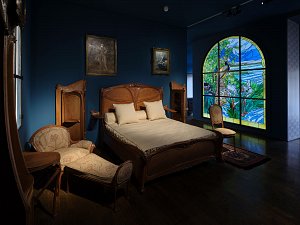Hector Guimard (1867-1942)

© MAD, Paris / photo : Christophe Dellière
Inspired by the Belgian architect Victor Horta, Hector Guimard systematised the use of lines derived from plant stems in the Castel Béranger, on which he was working at the time. This building in the 16th arrondissement of Paris brought him many commissions, especially for the entrances to the Paris metro in 1900. From 1902 to 1906, he built the home of the rich industrialist Léon Nozal, at 52 Rue du Ranelagh, in Paris. In 1903, for the wedding of Léon Nozal’s daughter Caroline-Madeleine to Albert Pézieux, Guimard provided a set of bedroom furniture in delicately sculpted pear wood with curves inspired by nature. The furniture followed the couple to various addresses before arriving at the Hôtel Nozal in the late 1910s.
Émile Gallé (1846-1904)

© MAD, Paris / photo : Christophe Dellière
One of the pioneers of Art Nouveau in France, Emile Gallé was a founder of the École de Nancy. This knowledgeable botanist was fascinated by Japanese art and was inspired by the simplest poetry of nature, wild flowers, insects and the seabed to create glass objects in which he experimented with all types of technical possibilities. Émile Gallé, commissioned by Édouard Hannon to make the furniture for his house, created the furnishings for the living room and the dining room shown here. The very high-quality furniture was delivered in the final quarter of 1904, just after Émile Gallé’s death. The decoration on the two buffets evokes the end of summer. The first has a wheat harvest, possibly referring to the furniture’s purpose: presenting bread. The same probably applies to the second sideboard, intended to hold glasses, showing scenes of vine harvesting. Épis de blé decoration in patinated bronze reinforces this theme. The furniture is all remarkable for the quality of inlay and veneering as well as the variety and number of types of wood used (such as walnut and kingwood) as well as its creative vegetal/plant inspired forms.